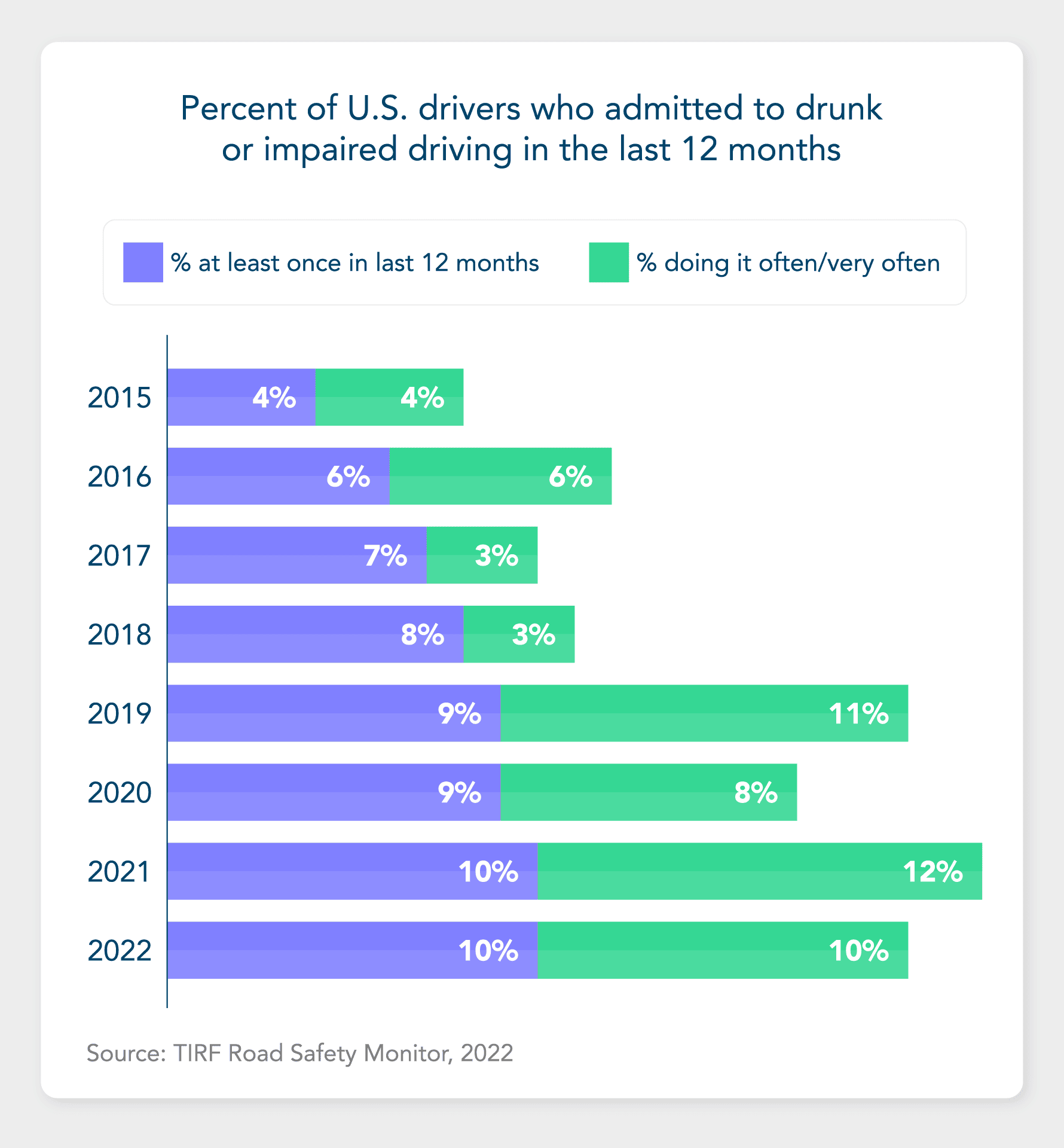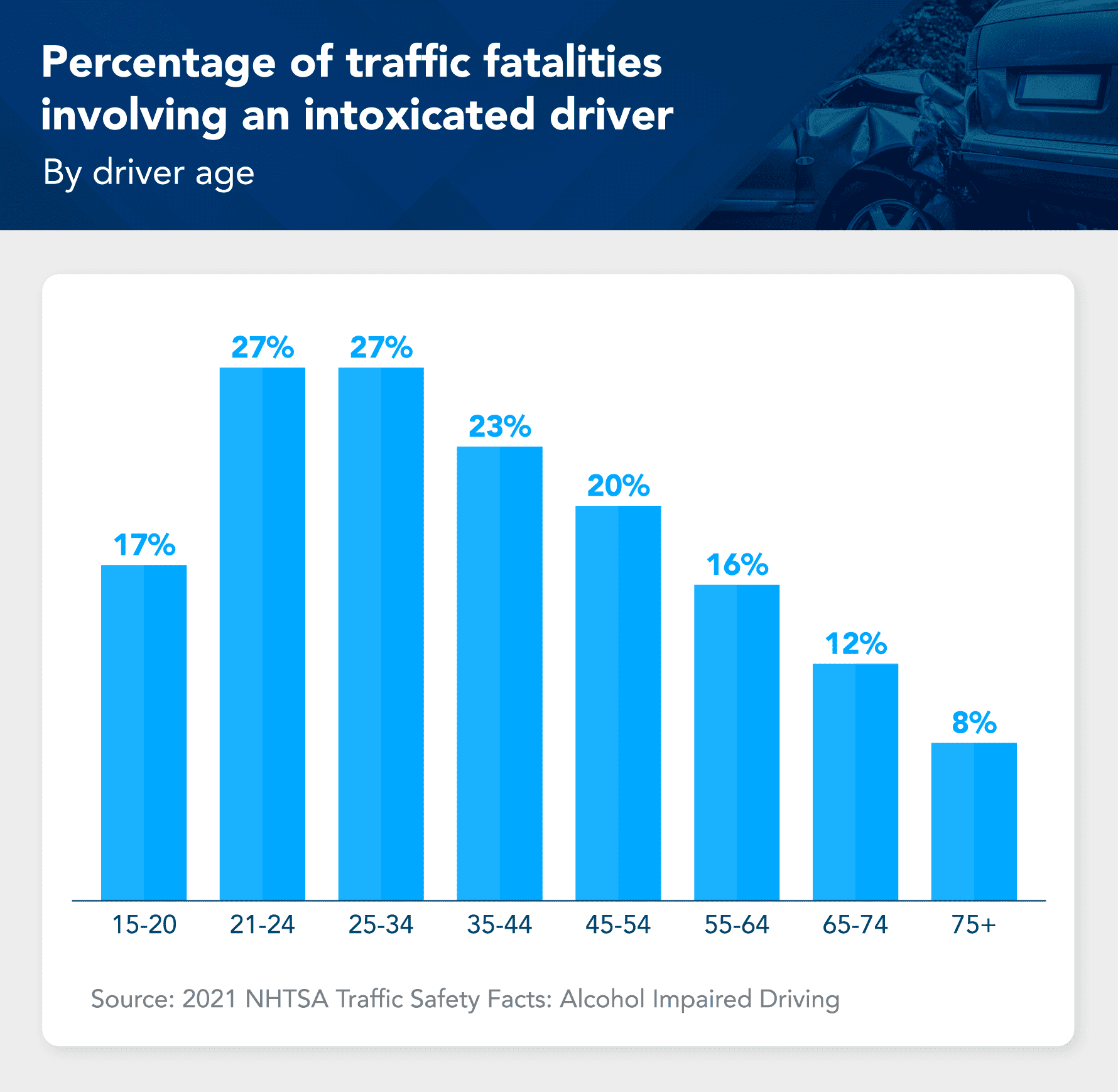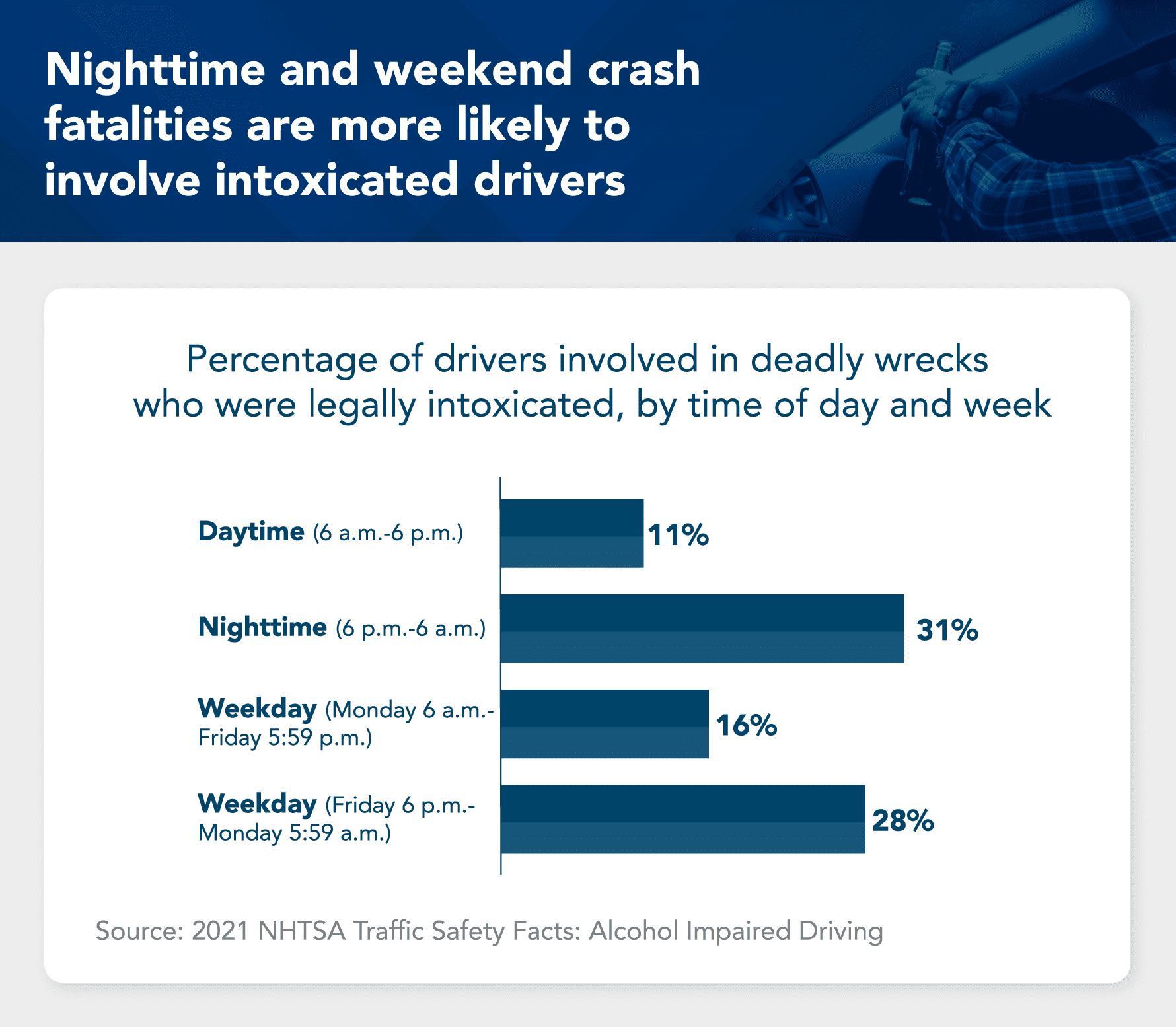DUI Statistics and Trends: 2023 Annual Report
In 2020, alcohol consumption among adults over 30 increased significantly in the U.S., as people isolated in their homes during a stressful pandemic. Soon, statistics showed an increase in deadly car crashes involving drunk drivers.
But as life returned to normal and businesses opened their doors in 2021, drunk driving deaths only continued to rise. To understand these troubling trends we examined National Highway Traffic Safety Administration (NHTSA) data for 2021, the most recent year available. We also explored the latest data from 2021 on DUI arrests from the FBI.
Here are some of our key findings:
- The number of deadly drunk-driving crashes rose again in 2021, killing 13,384 people. About 31% of all fatal crashes in 2021 involved drunk drivers.
- About 45% of traffic deaths in Montana involved drunk drivers in 2020, the highest rate among all states.
- Between 2020 and 2021, the number of drunk drivers involved in deadly crashes increased most in Alaska, the District of Columbia, and Idaho.
- Nationally, DUIs make up about one in 10 arrests. In Pennsylvania, about 25% of all arrests in 2021 were for drunk or intoxicated driving.
- In 2022, about 20% of drivers reported driving drunk at least once, and 10% said they did it often.
How Often Does Drinking Lead to Traffic Fatalities?
According to the NHTSA, fatal drunk-driving accidents rose in 2020 for the first time in five years and rose again in 2021. There were 13,384 people killed in drunk-driving crashes in 2021 (about one person every 39 minutes), an increase of 14% over the previous year. About 31 percent of all fatal car crashes in 2021 involved drunk drivers.
Though the recent increase in drunk driving fatalities is discouraging, drunk driving has decreased significantly since the early 1980s. Around that time, public awareness campaigns began to shed light on the dangers of drinking and driving. Nearly half of all fatalities in 1982 (48 percent) involved alcohol.
The NHTSA attributed the recent increase in drunk-driving deaths to several factors, including the easing of COVID-19 restrictions, which led to more people driving; the reopening of bars and restaurants, which made it easier for people to drink and drive; and the legalization of marijuana in some states, which can impair driving ability.
Who Is Most Likely to Drive Drunk?
Since 2015, the percentage of Americans who admitted to recent drunk driving has increased. Last year alone, about 20 percent of drivers reported driving drunk at least once, and 10 percent said they did it often. While the practice, unfortunately, is widespread, some drivers are more likely to drive under the influence.
Young drivers are likelier than their older counterparts to drive while intoxicated. More than a quarter of fatal-crash drivers between the ages of 21 and 34 had been over the legal alcohol limit. Younger drivers may be more likely to be involved in drunk driving wrecks because they may be more prone to exaggerate their ability to drive safely under the influence. They’re also more likely to drink alcohol in general and more likely to face peer pressure. In other words, if their friends drink and drive, they are more likely to do the same.
Men are also more likely to be involved in traffic crashes due to drunk driving compared to women. According to the latest statistics from the NHTSA, about 4 male alcohol-impaired drivers were involved in crashes for every female alcohol-impaired driver in 2021.
When Are Drunk Driving Deaths Most Common?
Driving drunk or high is prevalent and risky when it’s dark out. The chances of a fatal accident involving alcohol almost triple at night compared to the daytime and increase greatly during the weekends. This is often when people go out to bars, restaurants, or clubs serving alcohol.
There are several reasons why more drunk driving deaths occur at night. Firstly, there are simply more drunk drivers on the road at night. People are more likely to drink alcohol in the evening than in the day. Additionally, visibility is reduced at night. This makes it more difficult for drivers to see other cars and hazards on the road. Drivers are also more likely to feel sleepy at night, leading to slower reaction times and poor decision-making.
How Often Are People Arrested for DUI?
Of course, the most tragic result of drinking and driving is the loss of human life, but DUIs can create the risk of legal implications. Police arrested more than 443,000 people on suspicion of DUI in 2021, the most recent year for available FBI data. The number could be far higher since large states like Florida did not contribute to the latest FBI reporting.
Only simple assault and drug-related charges were more common crimes than DUI in 2021. Still, the 2021 DUI arrest figure represents a massive decline from the nearly 1 million people arrested in 2014.
Nationally, DUI accounts for about one in 10 arrests, which is much higher in some states. In Pennsylvania, about 25 percent of all arrests in 2021 were for drunk or intoxicated driving.
Percentage of all arrests due to DUI by state, 2021
| State | Percentage |
|---|---|
| Pennsylvania | 25.0% |
| Washington | 17.4% |
| Wyoming | 15.5% |
| Minnesota | 15.2% |
| Idaho | 15.0% |
| Montana | 15.0% |
| Maine | 14.9% |
| Alaska | 14.5% |
| Vermont | 14.1% |
| North Dakota | 14.0% |
| Mississippi | 13.9% |
| South Dakota | 13.8% |
| Michigan | 13.7% |
| Arizona | 13.2% |
| Iowa | 12.9% |
| Rhode Island | 12.8% |
| Oregon | 12.6% |
| Nebraska | 12.5% |
| Texas | 11.9% |
| Georgia | 11.8% |
| Indiana | 11.8% |
| Oklahoma | 11.5% |
| Illinois | 11.5% |
| Maryland | 11.5% |
| Kansas | 11.4% |
| New Jersey | 11.2% |
| Colorado | 11.1% |
| Missouri | 10.9% |
| Wisconsin | 10.8% |
| Nevada | 10.7% |
| New Hampshire | 10.7% |
| New Mexico | 9.5% |
| Utah | 9.1% |
| Massachusetts | 9.1% |
| New York | 9.0% |
| Virginia | 8.9% |
| Hawaii | 8.9% |
| Connecticut | 8.8% |
| West Virginia | 8.2% |
| Ohio | 7.2% |
| Tennessee | 7.0% |
| Kentucky | 7.0% |
| California | 6.1% |
| North Carolina | 5.9% |
| South Carolina | 5.9% |
| Arkansas | 4.9% |
| Louisiana | 3.1% |
| Delaware | 1.3% |
| Alabama | 0.6% |
Source: Arrests in The United States by Offense, 2021 Uniform Crime Reporting Program
Note: Florida submitted incomplete data
Conclusion
In 1910, New York was the first state to prohibit driving while intoxicated, although the law did not clearly define drunken driving. However, it was not until the 1970s that states and the federal government made efforts to reduce drinking and driving by implementing laws that criminalized driving while intoxicated. In the past, even though driving under the influence was illegal in many places, prosecutors faced challenges in proving it in court. In other words, BAC was not the sole determining factor; the observable impairment level played a crucial role.
It is difficult to argue against the effectiveness of stricter laws in deterring individuals from driving after consuming drugs or alcohol, considering the consistent decline in DUIs and DUI-related traffic fatalities. However, due to the increased alcohol consumption during the Covid pandemic and beyond, we can only hope that these achievements will not be reversed.
Our Data
We analyzed data from the 2021 NHTSA Traffic Safety Facts Report. This was the latest available year. Additional information came from the FBI’s 2021 Uniform Crime Reporting Program and the 2022 TIRF Road Safety Monitor.
Here is a full list of states’ drunk-driving fatality estimates from the 2021 and 2020 Traffic Safety Facts from the NHTSA (table 4).
| State | Number of drivers involved in fatal crashes with BAC .08+ (2020) | Percent of drivers involved in fatal crashes with BAC .08+ (2020) | Number of drivers involved in fatal crashes with BAC .08+ (2021) | Percent of drivers involved in fatal crashes with BAC .08+ (2021) | Percent change in number of drivers with BAC .08+, 2020-2021 |
|---|---|---|---|---|---|
| Alaska | 11 | 14% | 22 | 33% | 100% |
| District of Columbia | 7 | 13% | 12 | 30% | 71% |
| Idaho | 52 | 17% | 85 | 31% | 63% |
| Massachusetts | 95 | 20% | 150 | 36% | 58% |
| Delaware | 22 | 14% | 34 | 25% | 55% |
| Arizona | 276 | 19% | 421 | 36% | 53% |
| New York | 267 | 19% | 388 | 34% | 45% |
| Vermont | 16 | 21% | 23 | 31% | 44% |
| Utah | 57 | 14% | 79 | 24% | 39% |
| Louisiana | 219 | 20% | 299 | 31% | 37% |
| Nevada | 85 | 19% | 116 | 30% | 36% |
| South Carolina | 296 | 21% | 401 | 33% | 35% |
| Texas | 1,433 | 27% | 1,906 | 42% | 33% |
| Washington | 197 | 25% | 262 | 39% | 33% |
| New Hampshire | 34 | 23% | 45 | 38% | 32% |
| Illinois | 350 | 21% | 461 | 35% | 32% |
| Minnesota | 100 | 18% | 130 | 27% | 30% |
| Kansas | 85 | 15% | 109 | 26% | 28% |
| Alabama | 221 | 17% | 281 | 29% | 27% |
| California | 1,081 | 21% | 1,370 | 32% | 27% |
| New Jersey | 141 | 17% | 178 | 25% | 26% |
| New Mexico | 123 | 23% | 154 | 32% | 25% |
| Colorado | 173 | 20% | 216 | 31% | 25% |
| Florida | 825 | 17% | 1,019 | 27% | 24% |
| Montana | 86 | 35% | 104 | 44% | 21% |
| Oregon | 180 | 26% | 215 | 36% | 19% |
| Arkansas | 155 | 18% | 185 | 27% | 19% |
| Ohio | 451 | 26% | 531 | 39% | 18% |
| Iowa | 101 | 22% | 118 | 33% | 17% |
| Oklahoma | 165 | 18% | 192 | 25% | 16% |
| Tennessee | 309 | 18% | 355 | 27% | 15% |
| South Dakota | 46 | 25% | 52 | 35% | 13% |
| Hawaii | 25 | 22% | 28 | 29% | 12% |
| Michigan | 293 | 19% | 325 | 29% | 11% |
| Pennsylvania | 305 | 19% | 337 | 27% | 10% |
| North Carolina | 425 | 20% | 466 | 28% | 10% |
| Maryland | 178 | 22% | 195 | 35% | 10% |
| Kentucky | 180 | 17% | 190 | 24% | 6% |
| Mississippi | 150 | 16% | 155 | 20% | 3% |
| Virginia | 273 | 23% | 281 | 29% | 3% |
| Wyoming | 37 | 22% | 38 | 34% | 3% |
| Wisconsin | 194 | 24% | 199 | 32% | 3% |
| Indiana | 230 | 18% | 234 | 25% | 2% |
| Georgia | 390 | 16% | 391 | 22% | 0% |
| North Dakota | 33 | 24% | 33 | 33% | 0% |
| Missouri | 301 | 22% | 290 | 29% | -4% |
| Connecticut | 118 | 28% | 112 | 38% | -5% |
| West Virginia | 71 | 19% | 65 | 23% | -8% |
| Nebraska | 72 | 22% | 65 | 29% | -10% |
| Rhode Island | 29 | 32% | 24 | 39% | -17% |
| Maine | 61 | 28% | 45 | 29% | -26% |



